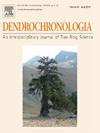Reconsidering the use of t-statistics in dendroprovenancing
IF 2.7
3区 农林科学
Q1 FORESTRY
引用次数: 0
Abstract
The t-statistic is a well-established parameter widely used in dendrochronology for cross-dating and, at least in preliminary stages, for dendroprovenancing. However, its application has increasingly been questioned due to its volatile validity and lack of clear statistical validation. This has prompted the adoption of alternative methods, though their implementation in dendroarchaeological contexts often presents challenges. This note aims to clarify key aspects of the t-statistic and its associated Pearson’s correlation coefficient in the context of dendroprovenance. In previous work, the authors demonstrated that, within the same species, a strong relationship exists between series correlation and geographic distance: higher correlations typically correspond to shorter distances between tree growth sites. Here, the focus shifts from the correlation coefficient to the t-statistic, highlighting both its potential and its limitations. Unlike the linear relationship observed between distance and Pearson’s correlation coefficient, the association between distance and the t-statistic is more pronounced at shorter distances, where correlations are higher. Additionally, the overlap between the tree-ring series has important implications in dendroprovenance analyses as a greater overlap facilitates high tBP values by making these values less informative.
求助全文
约1分钟内获得全文
求助全文
来源期刊

Dendrochronologia
FORESTRY-GEOGRAPHY, PHYSICAL
CiteScore
5.50
自引率
13.30%
发文量
82
审稿时长
22.8 weeks
期刊介绍:
Dendrochronologia is a peer-reviewed international scholarly journal that presents high-quality research related to growth rings of woody plants, i.e., trees and shrubs, and the application of tree-ring studies.
The areas covered by the journal include, but are not limited to:
Archaeology
Botany
Climatology
Ecology
Forestry
Geology
Hydrology
Original research articles, reviews, communications, technical notes and personal notes are considered for publication.
 求助内容:
求助内容: 应助结果提醒方式:
应助结果提醒方式:


